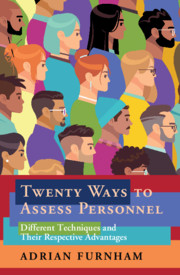Book contents
- Twenty Ways to Assess Personnel
- Twenty Ways to Assess Personnel
- Copyright page
- Dedication
- Contents
- Tables
- Preface
- Acknowledgements
- 1 Introduction to Selection and Assessment
- 2 Complex and Sticky Issues in Assessment and Selection
- 3 Traditional and Mainly Discredited Assessment Methods
- 4 Self-Report Tests
- 5 Observer Reports
- 6 Behavioural Tests
- 7 Physiology
- 8 Biography
- 9 Big Data
- 10 The Future of Assessment
- Index
- References
7 - Physiology
Published online by Cambridge University Press: 11 June 2021
- Twenty Ways to Assess Personnel
- Twenty Ways to Assess Personnel
- Copyright page
- Dedication
- Contents
- Tables
- Preface
- Acknowledgements
- 1 Introduction to Selection and Assessment
- 2 Complex and Sticky Issues in Assessment and Selection
- 3 Traditional and Mainly Discredited Assessment Methods
- 4 Self-Report Tests
- 5 Observer Reports
- 6 Behavioural Tests
- 7 Physiology
- 8 Biography
- 9 Big Data
- 10 The Future of Assessment
- Index
- References
Summary
Many assessors assume that it is always better to have physiological data to assess people because it is more accurate, subtle and less prone to errors like faking and impression management. The argument is ‘the body does not lie’. This chapter looks at four techniques that measure different aspects of behaviour: the EEG, the fMRI, the lie detector and voice analysis. There is some overlap in what these different techniques measure, but they all assume that physical data can give powerful clues into a person’s ability, personality and motivation. Whilst there has been a slowing down in research on the EEG and the polygraph because of weak and mixed results, there is a great deal of interest in the fMRI. Many claims have been made for what the fMRI measures though the cost of this research has meant it remains limited and, as yet, totally inappropriate for the assessment of people for jobs. There has also been a long-standing interest, mostly by law enforcement and insurance companies, in voice stress analysis to reveal the emotional state of speakers. The chapter is concerned with the validity of this sort of data and whether it could or should be used in job selection and general person assessment.
Keywords
- Type
- Chapter
- Information
- Twenty Ways to Assess PersonnelDifferent Techniques and their Respective Advantages, pp. 396 - 433Publisher: Cambridge University PressPrint publication year: 2021



